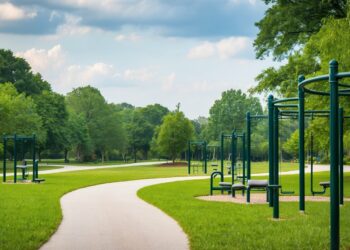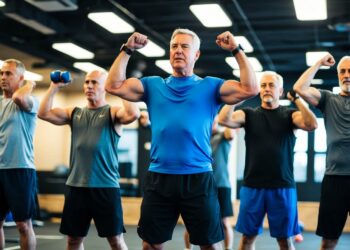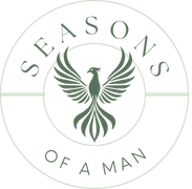Staying fit after 50 isn’t just about looking good—it’s about feeling great and living well. Many men wonder if they can still build muscle and strength as they age. The good news is that fitness after 50 is not only possible but essential for overall health and longevity.
For men over 50, the most effective fitness goals combine regular cardio exercise (at least 150 minutes weekly) with strength training twice a week using lighter weights for power development. We don’t need to train like we did in our 20s, but we do need to stay active. Low-impact activities like swimming, biking, or walking are excellent cardio options that are gentler on our joints.
Recovery becomes even more important as we age. For every 30 minutes spent working out, we should dedicate about an hour to recovery. Proper nutrition also plays a crucial role—eating enough protein helps build muscle and supports recovery after workouts. With the right approach, men over 50 can continue to build strength, maintain mobility, and enjoy an active lifestyle for years to come.
Understanding the Impact of Aging on Fitness
As we age, our bodies undergo natural changes that affect how we exercise and maintain fitness. These changes require us to adapt our approach to physical activity while addressing specific health concerns that become more common after 50.
Adjusting Expectations with Age
After 50, our metabolism naturally slows down, making weight management more challenging. We lose about 3-5% of muscle mass each decade after 30, a condition called sarcopenia. This doesn’t mean we can’t be fit—it just means our goals might need adjusting.
Strength training becomes especially important as we age. Research shows it helps rebuild muscle mass that naturally declines over time. Even better, muscles burn more calories than fat even at rest, helping offset the slowing metabolism.
Recovery also takes longer as we age. What used to take a day might now take two or three. We need to plan more rest days between intense workouts and pay attention to how our bodies feel.
Common Health Considerations for Men Over 50
Joint health becomes a priority after 50. Lower-impact exercises like swimming, cycling, and elliptical training can help us stay active while protecting aging joints from excess stress.
Bone density is another important concern. Weight-bearing exercises help maintain strong bones and reduce the risk of osteoporosis, which affects men too, not just women.
Heart health deserves special attention. Regular cardiovascular exercise helps keep our hearts strong and reduces the risk of heart disease—the leading cause of death for men over 50.
Balance exercises become crucial as we age. Falls are a major health risk for older adults, but regular balance training can significantly reduce this risk.
Before starting any new fitness program, we should check with our doctor, especially if we have existing health conditions like high blood pressure or diabetes.
Designing a Fitness Regimen for Men Over 50
Creating an effective workout plan after 50 requires thoughtful consideration of your changing body. We need to balance strength training, flexibility work, and aerobic activities to maintain muscle mass, mobility, and heart health.
Effective Strength Training Tips
For men over 50, strength training becomes crucial as we naturally lose muscle mass with age. Aim to work all major muscle groups at least twice weekly with exercises that are effective but joint-friendly.
Start with lighter weights and focus on proper form rather than heavy lifting. Try 3 sets of 8-12 repetitions for each exercise, taking about 2 seconds to lift and 2-3 seconds to lower weights.
Compound movements like squats, deadlifts (with proper form), chest presses, and rows give you the most bang for your buck. These exercises work multiple muscle groups simultaneously.
Rest is equally important! Allow 48 hours of recovery between training the same muscle groups. This recovery time becomes more essential as we age.
Consider working with a trainer initially to develop proper technique and a program tailored to your specific needs and limitations.
Incorporating Flexibility and Balance Exercises
Flexibility and balance work often gets overlooked, but they’re critical for preventing injuries and maintaining mobility as we age.
Dedicate 10-15 minutes to stretching after each workout when muscles are warm. Hold each stretch for 20-30 seconds without bouncing, focusing on major muscle groups like hamstrings, quadriceps, chest, and shoulders.
Balance exercises should be part of your routine at least twice weekly. Try simple exercises like standing on one foot, heel-to-toe walks, or tai chi movements.
Yoga classes designed for older adults offer tremendous benefits combining both flexibility and balance. Even one session per week can significantly improve your overall mobility and stability.
Remember that flexibility work isn’t just about preventing injury—it improves your performance in other exercises too!
The Role of Aerobic Activities
Cardiovascular exercise remains vital for heart health and weight management after 50. We recommend aiming for at least 150 minutes of moderate-intensity cardio each week.
Monitor your heart rate during activity—a good target range is about 50-70% of your maximum heart rate (roughly calculated as 220 minus your age) for moderate intensity work.
Low-impact options like swimming, cycling, and elliptical training provide excellent cardiovascular benefits while being easier on your joints than running.
Breaking up your cardio into shorter sessions is perfectly fine! Three 10-minute walks throughout the day offer similar benefits to one 30-minute session.
Mix up your cardio choices to prevent boredom and exercise different muscle groups. Try alternating between biking, swimming, and brisk walking throughout the week.
Consider adding intervals—short bursts of higher intensity followed by recovery periods—to boost your fitness and make workouts more time-efficient.
Nutrition and Lifestyle for Peak Performance
Proper nutrition and healthy lifestyle habits are essential foundations for fitness success after 50. The right food choices combined with adequate rest can dramatically improve your workout results and overall wellbeing.
Tailoring Nutrition for Muscle Growth and Recovery
As we age, our protein needs actually increase. Aim for 1.2-1.6 grams of protein per kilogram of body weight daily to support muscle maintenance and growth. This is higher than what younger adults require.
Quality protein sources include:
- Lean meats and poultry
- Fish and seafood
- Eggs
- Greek yogurt
- Plant options like beans and tofu
Don’t forget about balanced nutrition! Include plenty of colorful fruits and vegetables—at least five servings daily. These provide essential vitamins and antioxidants that help with recovery.
Healthy fats are your friends too. Incorporate avocados, nuts, olive oil, and fatty fish to support joint health and reduce inflammation from workouts.
Consider timing your meals strategically. A protein-rich snack within 30 minutes after exercise can boost recovery and muscle growth.
The Importance of Hydration and Sleep
Water is crucial for peak performance. Many men over 50 don’t drink enough fluids, which can hurt workout quality and recovery. Aim for at least 8 cups daily, and more on exercise days.
Signs you’re not drinking enough include:
- Dark urine
- Headaches
- Unusual fatigue during workouts
- Muscle cramps
Quality sleep is equally important as good nutrition. During deep sleep, your body releases growth hormone that helps repair muscles and tissues.
Most men over 50 need 7-8 hours of quality sleep. Create a relaxing bedtime routine by dimming lights and avoiding screens an hour before bed.
Consider natural sleep aids if you struggle with rest. Magnesium supplements, chamomile tea, or tart cherry juice can help promote better sleep without harsh medications.
Staying Motivated and Accountable
Keeping up with fitness goals takes both motivation and accountability. These two factors can make the difference between a short-lived exercise habit and a lifelong commitment to health.
Setting Realistic and Achievable Goals
When we reach our fifties, our fitness goals need to be both challenging and realistic. Start by writing down specific goals that matter to you personally. Instead of saying “get in shape,” try “walk 30 minutes five days a week” or “improve my bench press by 10% in three months.”
Break larger goals into smaller milestones that you can celebrate along the way. This creates a sense of achievement that fuels motivation.
Review your progress monthly. This helps you see what’s working and what needs adjustment. Don’t be afraid to modify goals as needed—flexibility is key to long-term success.
Remember that progress at this age may look different than when we were younger. Celebrate improvements in energy, strength, and mobility rather than focusing only on weight or appearance.
Building a Support Network
Finding workout partners can dramatically increase our consistency. Consider inviting a friend to join you for regular walks, gym sessions, or virtual workouts. Having someone expecting you makes it harder to skip exercise days.
Group fitness classes designed for older adults offer both guidance and community. Many men find that the social aspect of these classes becomes as rewarding as the physical benefits.
Virtual communities can provide support when in-person options aren’t available. Fitness apps and online forums connect us with others sharing similar journeys.
Family support matters too. Share your fitness goals with loved ones who can offer encouragement and occasionally join your activities. Their understanding helps when you need to prioritize workout time.
Working with a personal trainer, even occasionally, provides expert guidance and built-in accountability for men over 50.










